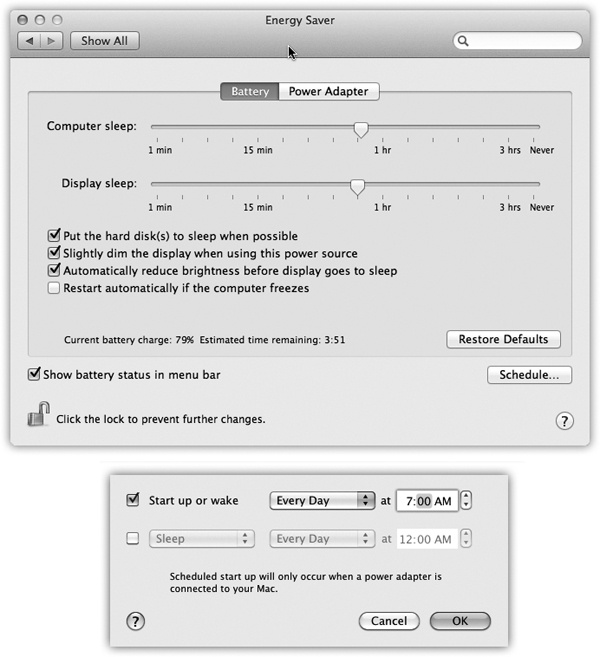The Energy Saver program helps you and your Mac in a number of ways. By blacking out the screen after a period of inactivity, it prolongs the life of your monitor. By putting the Mac to sleep after you’ve stopped using it, Energy Saver cuts down on electricity costs and pollution. On a laptop, Energy Saver extends the length of the battery charge by controlling the activity of the hard drive and screen.
Best of all, this pane offers the option to have your computer turn off each night automatically—and turn on again at a specified time in anticipation of your arrival at the desk.
The Energy Saver controls are different on a laptop Mac and a desktop Mac, but both present a pair of sliders (Figure 15-9).
Figure 15-9. Top: Here’s what Energy Saver looks like on a laptop. In the “Display sleep” option, you can specify an independent sleep time for the screen. Bottom: Here are the Schedule controls—the key to the Mac’s self-scheduling abilities.
The top slider controls when the Mac will automatically go to sleep—anywhere from 1 minute after your last activity to Never. (Activity can be mouse movement, keyboard action, or Internet data transfer; Energy Saver won’t put your Mac to sleep in the middle of a download.)
At that time, the screen goes dark, the hard drive stops spinning, and your processor chip slows to a crawl. Your Mac is now in sleep mode, using only a fraction of its usual electricity consumption. To wake it up when you return to your desk, press any key. Everything you were working on, including open programs and documents, is still onscreen, exactly as it was. (To turn off this automatic sleep feature entirely, drag the slider to Never.)
The second slider controls when the screen goes black to save power. Yes, you can make the screen go to sleep independently of the Mac itself, although there’s no screamingly obvious reason why you’d want to do that.
Below the sliders, you see a selection of additional power-related options:
Put the hard disk(s) to sleep when possible. This saves even more juice—and noise—by letting your drives stop spinning when not in use.
Wake for network access. This option lets you access a sleeping Mac from across the network.
Allow power button to put the computer to sleep. On desktop Macs, it can be handy to sleep the Mac just by tapping its
 button.
button.Restart automatically if the computer freezes. This option is handy if you leave your Mac unattended and access it remotely, or if you use it as a network file server or Web server. It ensures that, if your lonely Mac seizes up or crashes, it will start itself right back up again. (On a laptop, it’s available only when you’re adjusting Power Adapter mode.)
Tip
If you also turn on (or leave on) “Restore windows when quitting and re-opening apps” in System Preferences→General, then your Mac will both restart and restore everything you were doing. You may, in fact, never even realize that a crash or freeze occurred while you were away! (The telltale sign: Any Web pages you had to log into, like a banking Web site, will have logged you out.)
Slightly dim the display when using this power source. You see this checkbox only on the Battery tab for a laptop. It means “Don’t use full brightness, so I can save power.”
Automatically reduce the brightness of the display before display sleep. When this option is on, the screen doesn’t just go black suddenly after the designated period of inactivity; instead, it goes to half brightness as a sort of drowsy mode that lets you know full sleep is coming soon.
Show battery status in the menu bar. This on/off switch (laptops only) controls the battery menulet described in the box below.
Note
On a laptop, notice the two tabs at the top of the dialog box. They let you create different settings for the two states of life for a laptop: when it’s plugged in (Power Adapter) and when it’s running on battery power (Battery). That’s important, because on a laptop, every drop of battery power counts.
By clicking the Schedule button, you can set up the Mac to shut itself down and turn itself back on automatically (Figure 15-9, bottom).
If you work 9 to 5, for example, you can set the office Mac to turn itself on at 8:45 a.m. and shut itself down at 5:30 p.m.—an arrangement that conserves electricity, saves money, and reduces pollution, but doesn’t inconvenience you in the least. In fact, you may come to forget that you’ve set up the Mac this way, since you’ll never actually see it turn itself off.

